Text
THE END

Stats
I'm a bit of a goon for stats and lists, so as I close the book on this project, here are a few highlights.
Total word count: 181,231
Average review length: 497 words
Longest review: 1,761 words (138: Various Artists // Experiments in Destiny)
Shortest review: 131 words (303: Alice Coltrane // Journey in Satchidananda)
Most reviewed decade: 1970s (110)
Firstest review: Various Artists // Keep on Truckin' (1)
Lastest review: Patti Smith // Horses (365)
Middlest review: [TIE] Sandy Denny & the Strawbs // All Our Own Work (177) & Various Artists // The Paths of Pain: The CAIFE Label, Quito, 1960–68 (178)
Age: 37
Wives left: 0

Twelve of my favourites
1: Various Artists // Keep on Truckin': How a series of TV commercials made Americans crazy for novelty truck driving songs.
32: The Who // Meaty Beaty Big & Bouncy: A free, online personality quiz.
59: Nass El Ghiwane // Nass El Ghiwane: Moroccan legends, quibbling about hype stickers, and the gift of trances.
90: Joe Coleman // Infernal Machine: Exploring a well-remunerated "Outsider artist" and his fixation on serial killers (feat. the craziest picture disc I've ever seen).
92: Aquariana // Aquariana: Your introduction to Father Yod and the Source Family cult, plus some weirdo piano ballads.
179: Elvis Presley // The Sun Collection: I asked 17 of my friends (and my grandma) for their opinions on Elvis.
199: Zero Kama // Zero Kama: In 1983, Austrian Psychic TV-devotee Zoe DeWitt snuck into a charnel house and scavenged a pile of human bones, which she then fashioned into musical instruments. This is the music that resulted.
209: Rob Hertner // Bucky's Heartaches: I research a private press country record by a Texan expat in London, and unearth his life as a crackpot political figure in Britain and connections to a terrorist militia group.
227: Jim Sullivan // U.F.O.: A guide to six lesser-known private press folkies, prepared with the assistance of antiquarian D. John Christie.
256: Maria Tănase // I: Romania's answer to Edith Piaf, and a figure much in need of rediscovery.
270: Purple Mountains // Purple Mountains: On David Berman's last work, and writing through pain.
319: Gilbert Bécaud // Incroyablement: A lovestruck fool, but no dummy. Some thoughts on an irrepressible chansonnier.

These are so stupid
Blogs tagged "this is so stupid"
5 notes
·
View notes
Text
365: Patti Smith // Horses

Horses
Patti Smith
1975, Arista
There’s a man named Nicky Drumbolis who lives up in Thunder Bay, Ontario, in an apartment that doubles as perhaps Canada’s greatest bookstore almost no one has ever seen. The septuagenarian Drumbolis is short and nearly deaf, a master printmaker and eccentric autodidact linguist. For years he ran a second-hand shop on Toronto’s Queen St. called Letters, until push (the size of his collection) came to shove (skyrocketing rent) and he went north, where he could afford a sufficiently large space to spread out. Unfortunately, Thunder Bay has little market for antiquarian books and micro press ephemera, and his shop is located on one of the most crime-ridden streets in the country. And so, the transplanted Letters has no storefront—in fact, the building looks derelict, its windows boarded up and covered with what at first glance seems to be graffiti but on closer inspection resembles a detail from the cave paintings at Lascaux. Letters’ patronage is limited to the online traffic in rare first editions that brings him a small income, and the occasional by-appointment adventurer willing to make the long, long 1,400 km drive from Toronto or further abroad.
When you enter, you find yourself in what appears to be a well-kept single room used bookstore, the kind there used to be dozens of in every major city. Books of every type and topic line the shelves, neatly arranged by category, and a long glass display features more delicate items, nineteenth century broadside newspapers and the like, some so fragile they seem on the verge of crumbling into dust. But this is not, Drumbolis warns you as soon as you attempt to take a book off of the shelf, a bookstore: this room is a facsimile, a tribute exhibit to as he calls it, “the fetish object formerly known as The Book.” The real bookstore lies in the chambers beyond this front room, the full catalogues of bygone presses, the one-of-one personal editions he’s assembled over decades of following his personal obsessions, the stacks which crowd his own modest sleeping quarters.
To Drumbolis, the original utility of the book as a container and mediator of information is now effectively passed; virtually every popular book in existence has been digitized, their contents instantly available in formats that are better-indexed, more easily parsed, and more readily transferrable than the humble physical book ever allowed. To desire a book is to desire possession of the thing rather than its contents, this edition, this printing, perhaps this particular copy that once passed through the hands of someone significant. He can show you the copy of John Stuart Mills’ On Liberty that was owned by Canada’s founding father John A. MacDonald, and argue convincingly that this object helped set the course of a nation’s history; or a set of Shakespeare’s complete works bearing Charles Dickens’ ex libris, which sets off a long anecdote about how Dickens liked to troll his houseguests with a collection of fake bookshelves. Drumbolis’s collection is threaded through his life like an old wizard in a fantasy novel whose flesh has fused with the roots of a tree: he eats with his books and he sleeps with them; collecting fuels his arcane research and dictates where and when he travels; 25 years ago he uprooted his life when his collection bade him, and though he’s starved for company in the frozen city it chose for him, he abides.
youtube
My own case of collectivitis is not so advanced, though Lord only knows what I’ll be like when I’m Old (I’m currently 47). And despite the conceit of this blog, I’ve seldom spent much time in these reviews dwelling on the physical properties of my records, evaluating the relative merit of pressings and the like (or even mentioning which one I’ve got). But as I sit here listening to my copy of Patti Smith’s Horses for the first time, I feel a small but definite sense of wonderment. It’s an early ‘80s Canadian pressing, so near-mint I might’ve stepped back in time and bought it new, still with what I take to be the original inner-sleeve, pale azure (to match the Arista disc label) with a texture almost like crepe paper.
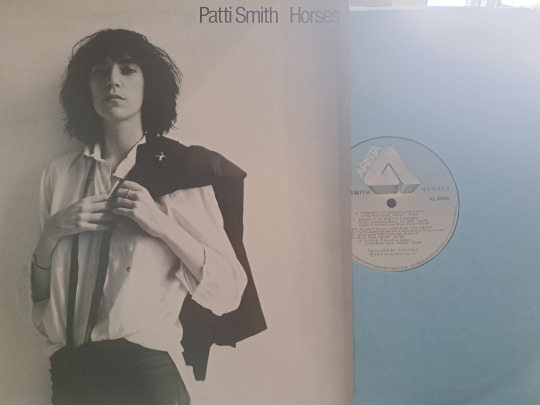
It’s a delightful, surprising contrast to the iconic black and white cover portrait of Smith by her former paramour Robert Mapplethorpe. Generations of fans have stared at this image as they listened, not simply because Smith is hot (though this is undeniably true) but because the music’s visionary qualities demand an embodied locus. That a record, unlike a book, can speak aloud, has always primitively fascinated me; that this one contains what I can only describe as rituals makes it magical, this physical copy that is unique because it’s this one that is speaking to me in this moment.
Smith writes on the back of the sleeve:
“…it’s me my shape burnt in the sky its me the memoire of me racing through the eye of the mer thru the eye of the sea thru the arm of the needle merging and jacking new filaments new risks etched forever in a cold system of wax…horses groping for a sign for a breath…”
“charms, sweet angels,” she concludes. “you have made me no longer afraid of death.” The record becomes an extension of Smith’s body as it existed in that time—I think here of the physicality of the moment in “Break it Up” where you can faintly hear her striking her own chest with the flat of her palm to make her voice quaver. It makes me wonder how anyone could sell this thing once they have it: not because it is particularly rare or difficult to acquire, but because it’s hard for me to imagine the experience of slipping the lustrous black disc from its dressing and setting the needle down upon it as anything but a personal one. It is poetry and waves; the subliming of the idea of a rave-up; Tom Verlaine shedding his earthly mantle in an explosion of birds; John Cale; Kaye, Král, Daugherty, and Sohl; one of my boys from Blue Öyster Cult; the pounding of hooves and the Mashed Potato.
I suppose what I’m describing is a fetish, my pleasure in acquiring these things and writing these reviews the hard and strange work of finding life’s joy in its dusty corners. This year has run through my fingers like water, as it seems they all do now. But on my good days, all these words behind me and the records in front of me seem like a document of abundance.
youtube
365/365
#patti smith#horses#john cale#lenny kaye#ivan král#blue oyster cult#tom verlaine#punk rock#art rock#female singer#poetry#collecting#music review#vinyl record#'70s music#the end
3 notes
·
View notes
Text
364: Various Artists // Israfel
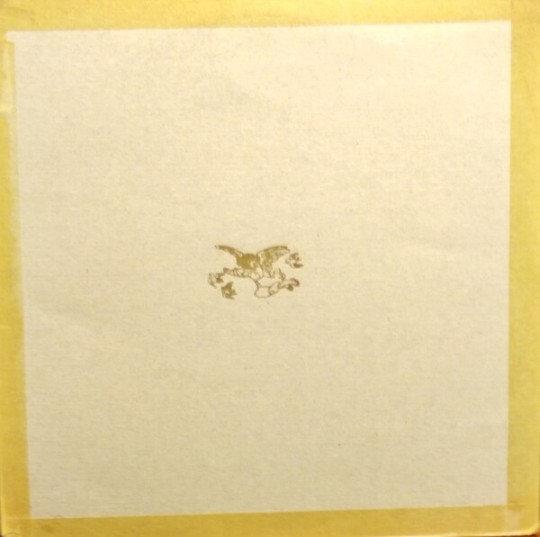
Israfel
Various Artists
1997, Ape
A 1997 vinyl benefit compilation of mostly Middle American grindcore / powerviolence / emo acts, assembled in an edition of about 1000 by Bloomington-based DIY label Ape Records (active 1995 to 2002), in handmade sleeve with a recent release catalogue, a substantial zine, and a few priceless gag inserts (incl. YOUR HARDCORE SELL OUT DECODER RING). I’m not an aficionado of any of the genres Israfel covers by any means, but you’d have to be a real head to know most of these: in terms of notoriety, the Locust (who contribute a 47 second blast of lo-fi outrage) are basically Led Zeppelin compared to the rest of the acts, most of whom topped out with a couple of EPs and compilation appearances.
youtube
Of course, hearing music that would otherwise be basically lost to time is the appeal of taking a flyer on a comp like this. One of my favourite tracks is “Untitled” by Roanoke, VA’s the Weak Link Breaks, supposedly the first thing the band ever wrote (and, judging from their discography, nearly the last too). It begins with a very, very quiet spacy-Fugazi-style amble (the vocal harmonies couldn’t be more Ian and Guy) that explodes into a brief screamo-style D-beat section, and then some big heaving riffs that make me want to exaggeratedly lift and stomp my feet like a giant trying to keep his balance. I also dig Murfreesboro, TN’s Serotonin, an emo / post-hardcore act with a steely '80s shred band guitar tone who play like they want people in the pit to twirl around ecstatically instead of slam dancing. A lot of the other nasty yowling cat speedballs on Israfel don’t really catch my ear, but that’s okay—I’m weirdly proud of them 27 years after the fact for being themselves and getting out whatever they needed to get out through this violence.
youtube
The package’s tone is all over the place. The zine opens with a haunting description of the compilation’s beneficiaries, the family of a pair of little girls with spinal muscular atrophy (a common birth defect) whose condition worsened until they perished, leaving their parents distraught and financially ruined—and the 21-year-old compiler racked with guilt that he didn’t somehow do more to help. From there, it whips through his heterodox thoughts about the hardcore scene (despicably self-absorbed; unresponsive to requests from label operators); the state of emo (too abstract); the best way to bring about change (working within the capitalist system); rape (it’s bad; consent is black and white; can we stop litigating this in the scene?); calling the cops (fine to do); disrespecting the American flag (played out; tacky); and drinking/drug use (“when did self-destruction become rebellion?”). After he finishes up, each band (that got their artwork in on time anyway) gets a page to talk about themselves. This section is full of old school punk zine/leaflet treasures, with designs that mimic motel newspaper ads, postcards, messy handwritten perzines, and Xeroxed 7” grindcore sleeves.
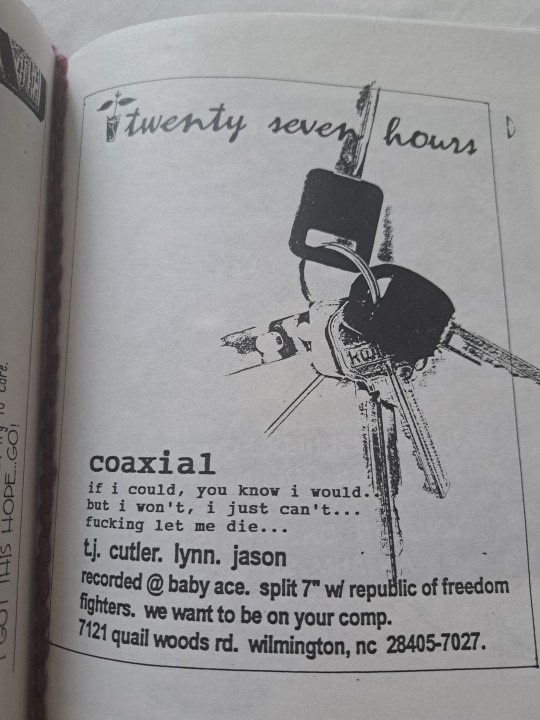
It's funny reading his scornful words about pseudo-rebellious drunkards stumbling toward “the day when punk rock is shelved for an 8 hour workday, Budweiser, and television” and then finding his LinkedIn, where he describes himself as “driving omnichannel excellence” and as “whimsical (after coffee).” You wouldn’t believe it from the splenetic angst of the Israfel zine, but the guy seems like he turned out happy and normal, with a few kids and a successful career. I wonder how the 21-year-old would see the 48-year-old, if he’d call him a sell-out or feel relieved that things worked out; if the 48-year-old would pity his former self, or feel ashamed about losing his edge. More one-time zinesters and hardcore kids end up looking square from a distance than you’d think (I certainly do if you catch me during the workday), because you usually stop hearing about them when they drop out of the scene. For most, the quiet part of life is the larger portion by far. It’s your choice whether to embrace that, mourn it, or seek your own alternative. But if Israfel reminds us of nothing else, it’s the importance of having a good scream at least once in your life.

364/365
#the locust#ape records#the panoply academy#architects of the new christ rebellion#criswell#harriet the spy#thenceforward#locust#inept#the weak link breaks#serotonin#old hearts club#twenty seven hours#eurich#the judas iscariot#reversal of man#screamo#post hardcore#d beat#grindcore#sasscore#zines#diy#selling out#'90s music#music review#vinyl record#emocore
5 notes
·
View notes
Text
363: R.E.M. // Murmur
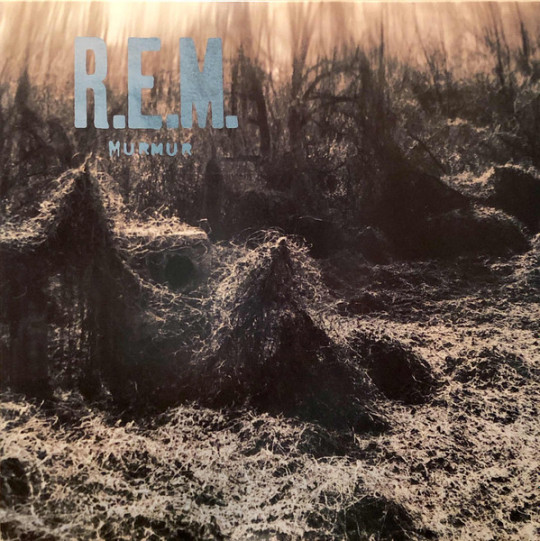
Murmur
R.E.M.
1983, IRS
Some Short, Disconnected Statements on the Matter of Murmur
1. Insert the following into Waring blender
The Velvet Underground, Pylon, the Byrds, Gang of Four, Patti Smith, the Feelies, Joy Division, the Method Actors, Big Star, the dB’s, the Monkees. Press “Blend” button. (I’ve never owned a blender; I don’t know what the buttons say.)
youtube
2. Easy formula for a great band
Having one temperamental genius songwriter guy sounds kind of hard to maintain. Have you considered simply getting four people who are really excellent and distinctive at the respective things they do (at least three of them great singers), who all write well, get along, lack substance abuse issues, have good taste, and modest egos? Why don’t more bands do this?
3. Notes on the early discourse
A lot of the things people wrote back in the early ‘80s to champion this band were dumb as hell. R.E.M. weren’t good because they didn’t use keyboards or synths; pop music didn’t need to be returned to its "honest" folk-rock roots; giving them a thumbs up for not wearing flashy clothes and makeup is dork behaviour.
They were good because they made weird music that derived organically from their time (early ‘80s), place (a college town in the South), and selves (bright, independent, adventurous, sincere, ¼ gay).
Anyone who listened to Chronic Town or Murmur, with their post-punky murk and lyrical references to Laocoön and Marat, and thought to themselves, “As yes, the second coming of Roger McGuinn, this will put those effete new wavers to flight,” was an idiot.

4. Veteran of the psychic war
Somewhere around age 22, R.E.M. took over the mantle Metallica had held as My Favourite Band in the World Forever and Ever, and I proceeded to be almost as annoying about them as I had been Hetfield and the boys. I posted a lot about them; rigged “best music” polls on random message boards I didn’t even post on in their favour; cornered people at parties; crowbarred them into playlists; grumpily chose to dislike bands I saw as stealing their shine; etc. etc. Some (some) of this is maybe cute in retrospect, but really: don’t be like this about music. If you love a band this much, learn how to play their songs on an instrument; write a few poems; paint something. Worst case: review them.
5. Learning nothing, 2024
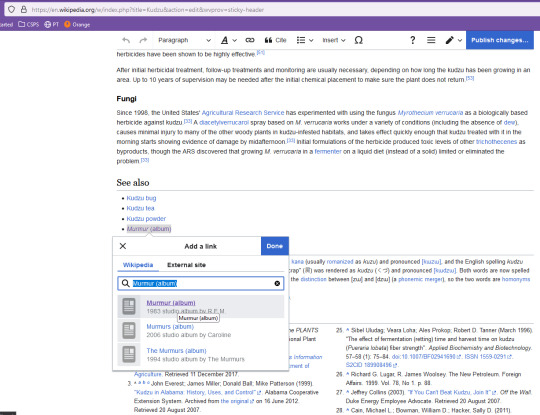
6. Athens: Lyrics & Enunciation
The matter of what exactly Stipe was singing on the early R.E.M. records was a subject of intense speculation, and eventually, parody. Some of the mystery’s in the mixing, some’s in his Georgian accent, and some’s in his enunciation (never quite as mushy as people claimed, but not exactly Ella Fitzgerald either). But most of it’s in the arbitrary decisions he makes with regard to syntax that cause even accurate transcriptions to seem implausible. Stipe is probably a little bit autistic, which goes some way to explaining the impressionistic intuitiveness of his words, and also went to art school, which fetishizes that sort of thing, but he was always shy of people seeing the words to something like “Sitting Still” on the page because he thought he might be exposed as a nincompoop. “Up to par and Katie bars / The kitchen side, but not me in / Sitting top of the big hill / Waste of time sitting still,” goes the chorus, according to at least one gnostic sect, but the important passage is the one everyone agrees on, when the stream of impassioned babble releases into a howled “I can hear you / Can you hear me?”
youtube
Later on, when he would sing more clearly over airy arrangements, with the lyrics neatly printed in the booklet, he’d occasionally try one of those old sound-over-sense moves and embarrass himself (“Leaving New York was never my proud” still rankles). But Murmur’s eternal elusiveness is in the way fragments of sense catch your ear from out of its sleeptalk glossolalia:
“The pilgrimage has gained momentum”
“Conversation fear”
“Lighted, lighted / Laughing in tune”
“Hear the howl of the rope / A question”
“A perfect circle of acquaintances and friends / Drink another, coin a phrase”
“Shaking through / Opportune”
“Take oasis”
“Heaven assumes / Shoulders high in the room”
“Did we miss anything?”
7. Permission to be arbitrary
I remember sitting in the basement of my college house with my old hometown buddy Brad (mostly a metal/classic rock guy), playing him “Shaking Through” and explaining one of the things I love about old R.E.M. is that it’s great music to yell to. I don’t know how much he really got it, but we were drunk and it’s a catchy song, so we howled and made keening, wordless, Stipean noises along with it and the next few until one of my roommates came and asked us to keep it down.
Also: one theory for why cats purr when they’re injured is that the vibrations somehow reduce pain and encourage healing. From many experiences humming these songs while wrapped up in headphones and bedsheets in the middle of a day that’s passing like a kidney stone, I can confirm.
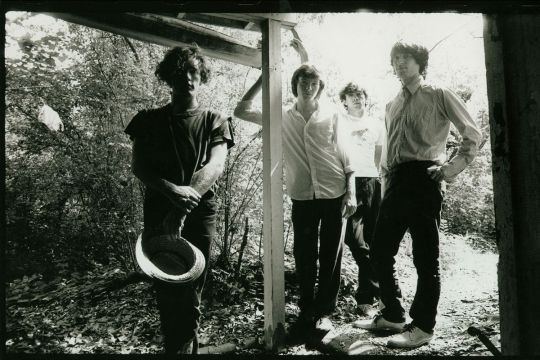
8. Note on the modern discourse: Influence?
Black Francis, Kurt Cobain, Bob Mould, Steve Malkmus, Bob Pollard, and Thom Yorke loved R.E.M. So did, to his own apparent consternation, Metallica’s Cliff Burton. Still, you sit down with someone and listen to those musicians with the goal of showing them the R.E.M. influence (don’t do this, why would you do this?) and it’s honestly pretty oblique. Most of the bands who directly aped aspects of R.E.M.'s early sound were at best pleasantly minor (see Captured Tracks’ Strum & Thrum comp), and the ones who seemed to be listening most closely to their ‘90s efforts were not who you want.
Their ultimate influence was probably simply showing what an art-first, indie-adjacent rock band could accomplish by sticking to their guns and bending the system to their desires instead of being bent by it. They were like a Velvet Underground for the college rock era, except everyone talented who heard them was inspired to start a band that didn’t sound much like them. They always used their spotlight to introduce people to other bands and, when they really got huge, they modeled how to deal with success. There don’t seem to be many R.E.M. stories, Peter Buck’s airplane incident aside, about them being anything other than kind. That’s a fundamentally less exciting type of influence than most other “great” bands have. But I do think it’s kinda cool they were the wise old heads for an entire national movement of alternative music.
8b.
Of course, it still bugs me people don’t think they’re cool. Murmur at least, should be considered cool. And Reckoning, mostly. Chronic Town for sure. Some of Fables. Am I crazy for saying some of Monster and New Adventures even? I’ll stop. I’ll go on.
9(-9). The music
They were a pop band, they were an art band; they sounded like children, and like craggy old men buried in kudzu weed; natural and pretentious; date-stamped and timeless. Decide yourself. Happy 41st birthday Murmur.
youtube
363/365
#r.e.m.#rem#michael stipe#peter buck#bill berry#mike mills#murmur#mitch easter#jangle pop#athens music#athens#'80s music#college rock#alternative rock#indie rock#perfect circle#self indulgence#music review#vinyl record
10 notes
·
View notes
Text
362: White Lung // Sorry

Sorry
White Lung
2012, Deranged (Bandcamp)
White Lung, who called it quits in 2022, were one of the best hardcore bands of their era, blessed with a screaming, instantly identifiable guitar sound; a commanding frontwoman; and a rhythm section that absolutely never let up. On 2012’s Sorry they rip through ten songs in 19 minutes, and every one of them still makes me feel like I have nitro boosters strapped to my shitty old bike. (Consider making White Lung required listening for DoorDashers?) When I close my eyes, I picture each downbeat as a railroad crosstie hurtling by, Kenneth William’s high-pitched guitar licks popping like Catherine wheels (as Pitchfork’s Laura Snapes once unforgettably described his sound), peroxide blonde Mish Barber-Way coiled up front in her ratty leopard print like the spawn of Courtney Love. Her lyrics are a ratqueen of body dysmorphia, assault trauma, and drug use, all delivered with a finger crooked towards abusers like a chthonic goddess of scene vengeance. But it’s also pit-party music: on pure pleasure, “Glue” is probably my favourite punk song of the past 15 years or so.
youtube
I remember when 2022’s Premonition (their swansong) dropped there were some people in my circles who were incensed that reviewers didn’t pan the record out of hand on account of Barber-Way being a fascist or a TERF or something. She was executive editor of Penthouse at the time, but I’m not sure if she still is since she’s killed all of her socials (I may have been the first guy in a minute to earnestly try to find a Masthead page on the Penthouse website). During her tenure she seems to have run the mag pretty much in line with its tradition of horny libertarianism, albeit with a heavier serving of Camille Paglia quotes. (Make that a much heavier serving of Camille Paglia quotes.) I would not be remotely surprised if her beliefs skew rightward on a lot of issues, and I get it’s disappointing any time someone whose work you respect starts to look increasingly reactionary with age. With that said, if you got something from this band, it’s still yours no matter how many episodes of Red Scare the woman who wrote them has binged. I’d like to think music this uncompromising in its advocacy for girls and crazy riffs will always find people who can use it to their own liberatory ends.
362/365
#white lung#mish barber-way#penthouse#'10s music#hardcore#vancouver#vancouver music#vancouver punk#punk#female singer#female musicians#vinyl record#music review#feminism
1 note
·
View note
Text
361: bill bissett & The Mandan Massacre // Awake in Th Red Desert

Awake in Th Red Desert
bill bissett & Th Mandan Massacre
1968, See/Hear Productions (Bandcamp)

(From “mor memoreez uv marvara reel konversaysyun,” scars on the seehors, Talonbooks 1999)
That’s a sample of how poet bill bissett’s writing looks on the page, phonetic and arbitrary, intuitive and free, while also checking the reader from taking any word for granted. The poems are frequently conversational in tone, but the way you have to sound out his writing to understand it means the reader's cadence ends up replicating the idiosyncratic singsong way bissett speaks. The 84-year-old remains a one-of-a-kind live performer, doodling all over the line between spoken poetry and song. He croons nonsense lullabies and pastiche ragas, shakes a maraca, intones mantras until their familiar words lose all their sense, even dances a little. It’s funny—I wouldn’t recommend his writing to someone unfamiliar with the avant-garde, but I would confidently take just about any open-minded person to see one of his shows. He has the affect of a holy fool or a joyful monk, and basically anything he does makes more sense in the context of his corporeal presence.
youtube
Back in 1968 though, bill was a wild young man, and Awake In Th Red Desert, his LP with backing “band” Th Mandan Massacre, is full of noisy freakouts and some patience-testing explorations. The Massacre includes four percussionists, some trained (jazz drummer Gregg Simpson) and some not (poet Martina Clinton, bill’s then-partner); electric guitar; two flutes (one a toy); and cutting edge Buchla Box synthesizer by the otherwise unknown Wayne Carr. Response to Red Desert has been pretty mixed—one of its Bandcamp uploads even warns, “Please preview the tracks before downloading. There are no refunds.” I suspect many listeners don’t make it past the first side of the record, which often sounds like what it is: clattering free improvisations around bissett’s sung or shouted recitations. On the flip though, things mellow out for some fascinating minimal synth explorations, bissett doing his visionary thing on a haunting electronic field (see “fires in the tempul”). “she, still and curling” is particularly freaky, Carr making sinister cricket noises with his Buchla, tape of bissett’s voice chopped up into hypnotic loops, layered and manipulated till it sounds like a collage of short wave radio transmissions. The ramshackle noise of the early tracks eventually returns on the awesome “now according to paragraph ‘c’”: bissett reads what (initially) seems like a found text that gets weirder and bolder as the poet works himself into a lather, the Buchla’s bleak tones tattered by the percussion squad’s stiff beat.
youtube
I snagged this off Montrealer Alex Moskos, who oversaw the reissue for Massachusetts-based avant-garde label Feeding Tube, and getting this thing back out there has clearly been a labour of love for him (the production quality is impeccable; great explanatory liner notes too). Are there 500 people who want this record? I’m not sure. But for fans of bissett, sound poetry, freaky music, and early electronic, this’ll be of interest. One idea: tell people Awake was the work of a solar death cult leader from the Pacific Northwest who disappeared during an eclipse and they won’t be able to keep the damn thing in stock.
361/365
#bill bissett#sound poetry#avant garde#'60s music#canadian music#blewointment#talonbooks#bpnichol#canadian poetry#poetry#concrete poetry#performance art#freak folk#buchla#music review#vinyl record#counter culture
5 notes
·
View notes
Text
360: Dusty Springfield // Dusty Springfield's Golden Hits

Dusty Springfield's Golden Hits
Dusty Springfield
1966, Philips
These early Dusty Springfield singles really get the “Wall of Sound” production treatment, despite Mr. Spector’s absence from the credits: mixed loud as hell like the kids liked it, screaming string charts, backing vocals en regalia, and a big beat knocking around underneath. Folks love to cite her as the second artist of the British Invasion to hit the U.S. charts, and for cultural reasons that may be significant, but her early sound was indistinguishable from American acts like Lesley Gore and the Shirelles. I don’t know many of the details about her career, but it seems like whoever was managing her was hell-bent on breaking her in the States. Call it a credit to English ingenuity (and specifically arranger Ivor Raymonde) that they were able to give Springfield a knock-out sound that passes for the contemporary Hollywood (or Detroit) product.
youtube
Dusty Springfield’s Golden Hits, her first major compilation, is Brill Building / girl group-style music par excellence, with a murderer’s row of hitwriters from both sides of the pond (Bacharach/David, Goffin/King, Beatrice Verdi/Buddy Kaye, etc.). Practically anyone could’ve had chart success with these songs and this packaging (and a number of these were subsequently hits for others), but Springfield had a cannon of a voice on her that makes the best of these numbers undeniable. Those who place her voice with the Arethas and Dionne Warwicks wish she’d been guided towards soul or sophisticated torch songs from the start, but I personally love it when someone vocally overqualified for bubblegum is made to tear into a good bop. “I Only Want to Be With You” is buffeted along by the force of her voice, the violins shrieking like a 33rpm record dragged up to 45; “Little By Little” could’ve been written for a Motown powerhouse like Darlene Love (but scarcely improved on by her); “I Just Don’t Know What to Do With Myself” moves from the sound of a girl sadly combing her hair before her vanity to Sampson bringing down the temple.
There’s plenty of treacle here, and “Wishin’ and Hopin’” probably set feminism further back than “He Hit Me (It Felt Like a Kiss),” but this is a worthy addition to any ‘60s pop library.
360/365
#dusty springfield#'60s music#'60s pop#british invasion#burt bacharach#hal david#gerry goffin#carol king#buddy kaye#beatrice verdi#r&b#girl group#motown#i just don't know what to do with myself#arliss#music review#vinyl record#female singer
5 notes
·
View notes
Text
359: Doug Snyder & Bob Thompson // Daily Dance

Daily Dance
Doug Snyder & Bob Thompson
1973, New Frontiers
An inspiring document, and a supremely loud one. Two smalltown Ohio guys move to Cincinnati in the late 1960s, circulate around the local university and garage rock scenes, and tip themselves to the hippest avant-garde music out there: the Velvets and the MC5, Cecil Taylor and Sonny Sharrock, Partch and Olatunji and Bley. Around ’72-’73 they record a noise rock duo LP in a Fayette County farmhouse that is about as sonically exfoliating as anything I’ve heard from Les Rallizes Dénudés or Sharrock or any of the era’s other decibelnauts. I grew up across Lake Erie from where they were playing and, if I’d been alive then, on a clear night I’d probably have been able to hear them.
youtube
The pieces are largely improvised, and while there are a few moments where they lose that ineffable telepathic thread that even the freest music needs to feel vital—Snyder falling back on some sub-Hendrix-y divebombing while Thompson tips and taps his cymbals the way I drum on my notepad with my pen when stuck on a thought—for the most part it is very much the “Abstract, but terribly immediate music” their old schoolmate Richard Riegel called it in the pages of Creem. Thompson was a well-seasoned jazz drummer, and his playing here is fascinating, his rhythm unerring despite using his kit to create a roiling cloud of percussion. Snyder doesn’t use anything like the arsenal of pedals and effects of many of today’s players, but he coaxes a remarkable array of sounds from his wah pedal and Vox Royal Guardsman Amp, basically skronking his ass off the whole way through, though he occasionally dips into some riff-shaped ideas.
Daily Dance didn’t sell much, and its direct influence is minimal, but it’s a hell of an avant-garde noise record for its era or any other. Snyder and Thompson continued to play together throughout their lives too—it warms my heart to think of them growing together over the years, though for their sakes I hope they turned the amps down eventually.
359/365
#doug snyder#bob thompson#free jazz#noise rock#avant garde#private press#improvisation#improvised music#psychedelic#sonny sharrock#les rallizes dénudés#'70s music#ohio music#music review#vinyl record
3 notes
·
View notes
Text
358: Carnivore // L'avenir t'attend pour souper

L'avenir t'attend pour souper
Carnivore
1983, La Collection
Very, very little online about this one (to the point that search results are clogged with random Francophone food writing), Carnivore were an absurdist Quebecois party band active in the late ‘70s and early ‘80s. The single extant video online (uploaded by the band’s former bassist) shows a group of guys in eccentric costumes (wounded soldier; Native head dress guy; caveman; safari gear-haver; Hawaiian shirt-wearer) alternately rocking out and answering questions about themselves with that philosophical air young musicians get when interviewed by the national broadcaster.
youtube
Carnivore’s sound is a little bit difficult to pin down. In the circa 1980 video the touchstones are Beefheart and Zappa, a funky, jazzy, bluesy approach to weirdo music filtered through a distinctly Queb aesthetic. By the time they released 1983’s L’avenir t’attend pour souper (or The Future Awaits You for Dinner, which is very), they’d dropped the sax and harmonica players in favour of a standard rock four-piece configuration that plays everything with a bit more of a new wave jiggle. The closest thing I can compare it to is the kind of pop that proggers were making in the ‘80s, stuff like Adrian Belew’s Lone Rhino. Carnivore lacks the kind of instrumental flare guys like Belew brought to the table, but L’avenir is still a grand old time, catchy in its peculiar way and a breezy listen compared to the patience-testing provocations of the band’s idols.
There’s a bit of a blank spot in Canada’s cultural memory for its early alternative bands, but Carnivore are a missing link between ‘60s pranksters like the Rabble and the contemporary genius of Gatineau’s Fet.Nat, even if the odds are good none of those three ever heard tell of any of the others.
358/365
#carnivore#'80s music#quebec music#quebec city#quebec city music#queb#queb rock#new wave#experimental rock#music review#vinyl record
1 note
·
View note
Text
357: Hailu Mergia & Dahlak Band // Wede Harer Guzo

Wede Harer Guzo
Hailu Mergia & Dahlak Band
1970s, Ms Recording (Bandcamp)
I can’t 100% recall, but I’m pretty sure this was the first African record I ever bought (it was this or Nass El Ghiwane), and I wasn’t the only one—I’ve got a few friends with exactly one African record in their collection, and it’s this. When his music was rediscovered in 2016 after Awesome Tapes From Africa pressed this record (using Mergia’s own cassette copy as a source), Wede Harer Guzo became for western music nerds a part of that small company of gateway albums to the music of an entire continent. Let’s play a game of Remember Some Guys.
Remember Some Guys: That One African Record Edition
Expensive Shit
Who is William Onyeabor?
Wede Harer Guzo
Nigeria 70 (The Definitive Story of 1970’s Funky Lagos)
A dollar bin Miriam Makeba LP
uh
TEN$ION
Remain in Light (honorary)
God I’m tired. Anyway, I’ve always had kind of an uncertain relationship with this record. Mergia’s organ can sound like a cool balm on my aching brain or… elevator music. Dahlak Band can sound like a perfect fusion of the floaty “intellectual highlife” of Celestine Ukwu and the grooves of Booker T. and the MG’s… or, what were we talking about? An entire side just past me by unnoticed, yet again. I think this has more to do with me than it does with the record… though at a cassette-length hour-plus run time, some ideas do get repeated.
(Three ellipses in one paragraph… I think that’s more than I’ve used in this whole series so far. I’m so tired of writing these things man. I’m not even really divorced, I can’t wait to leave.)
youtube
Anyway, again, at its best, the record is transcendently beautiful. The way Mergia’s organ expands and contracts like the shimmer of light on dark water on “Anchin Kfu Ayinkash,” guitarist Dawit Kassa answering his pauses with little soulful licks… there the ellipses go again. Sometimes the record feels like it’s insinuating I should go to the lobby for more popcorn. Maybe I’ll buy Raisinettes?
It’s very good I’m saying, obviously. See you tomorrow.
357/365
#hailu mergia#dahlak band#ethio jazz#ethiopia#ethiopian music#african music#jazz#funk#music review#vinyl record#awesome tapes from africa#remember some guys#defector#'70s music
5 notes
·
View notes
Text
356: Elvis Costello & the Attractions // Get Happy!!

Get Happy!!
Elvis Costello & the Attractions
1980, F-Beat
Get Happy!! was the first of Costello’s explicit genre exercises—the genius of the new wave does R&B. The emphasis is on his virtuosity as a pop songwriting machine, meaning neither his venom nor his wounded bitterness bite like they had on his three previous masterpieces. His lyrics are a multiply-compacted sediment of entendre, rhyme frequently leading sense, basically the point where power pop and backpacker rap improbably meet. It is, in every respect, the Evil Buddy Holly showing off for twenty songs. It might be the best record any Elvis ever cut.
youtube
Like a hummingbird, I need a lot of sugar to stay aloft sometimes, and the opening six songs of Get Happy!! give it to me uncut: “Love for Tender” with its hysterical army of extra Elvises on backing vocals; the sophisticated chirp of “Opportunity” (“The chairman of this boredom is a compliment collector / I'd like to be his funeral director”); breakneck Northern Soul raveup “The Imposter”; strolling sock hop blues "Secondary Modern”; the galloping piano heroism of “King Horse”; and “Possession,” a song that sounds like trying to win your girl back while she’s trying to get across the stage in her robes and tassel to accept her college degree. (I don’t exactly know what I mean about that last one either.) The fourteen tracks that follow hit those heights a little more sporadically, but most are good, some are confounding in an appealing way, and the best of them (“New Amsterdam”; “I Can’t Stand Up…”; “Temptation” etc.) are indispensable gems.
Much of the credit, as always, goes to the Attractions, one of the great rock combos ever assembled. Bruce Thomas is the John Entwistle of new wave, a one-of-one monster whose restless virtuosity frustrated the comparatively technically-limited guitarist who led his band—a virtuosity that nonetheless helped make even the occasional middling tune relentlessly groovy. Pete “No Relation” Thomas was a drummer who could play anything with power and a jazzy grace (check what he does given a little space to work on “Motel Matches”). Meanwhile, Steve Nieve, wielding his array of oddball organ tones, handles the lead melody on nearly every track—it’s the flexibility of his instrument that gives Costello’s lean four-piece its capacity to sound like a giddy R&B dance band, or a spangly, orchestrated chamber pop act, or any other costume Elvis might choose to wear on a given day.
youtube
356/365
#elvis costello#elvis costello and the attractions#steve nieve#bruce thomas#pete thomas#nick lowe#new wave#'80s music#r&b#soul#music review#vinyl record
0 notes
Text
355: Motörhead // No Remorse

No Remorse
Motörhead
1984, Bronze
I heard British comics writer Warren Ellis tell a story about hearing a horrible banging in the hallway outside his flat late one night in the mid-1980s. When he poked his head outside to give the noisenik hell he discovered Lemmy wandering around smacking the walls with a wooden cooking spoon. After he managed to get the metal legend’s attention, Lemmy waved the implement at him and snarled, “You ever hear of a coke spoon? This is my coke spoon!”
youtube
*
This past Friday, I talked to a 50-something punk named Joey P who has 26 Motörhead records on vinyl (including the coveted leatherbound version of No Remorse). If you ever want to have a long conversation with Joey P, I recommend starting with a riff on if Ronnie James Dio was a mob-connected / Rat Pack wiseguy, and then letting him go into antiquarian detail on which Motörhead records are kind of underrated (Another Perfect Day), underrated (Bastards), and really underrated (1916). Love that guy, and I think he’s mostly right. 26 is probably too many Motörhead records even for me, but they are one of those long-running, very sonically consistent bands who turn their deepest fans into sommeliers. I can hold forth about the subtle differences in tasting notes between an Ace of Spades and an Iron Fist (let alone a departure like Orgasmatron!) while an outsider looks doubtfully into their two indistinguishable cups of Jack and Coke. A band like this gives men of a certain age a way to sniff each other over when they meet in a clearing, a low-impact ritual of butting heads.

*
For years I remembered a story I thought one of my friends had told me about running into Lemmy at the Dominion Tavern in Ottawa towards the end of his life. He was miserably drinking white wine on his doctor’s orders, not looking for conversation. The image always struck me as both funny (I cannot imagine the house wine at the Dom having a nice finish), and sad (the day Lemmy Goddamn Kilmister lets anyone tell him he can’t have whiskey!). I think I’ve repeated it once or twice over the years as an example of how age mellows us all, but when I asked the pal I thought had told me, she denied it (though she did add that her ex told her Lemmy’d gone to see “the rippers in Aylmer once”). So, I dunno, maybe he escaped the fate of the Dom Chardonnay.

*
Speaking of fate, Lemmy was a damned sharp fellow beneath all the drugging and boozing (who else could’ve written the lyric “Fourth day, five-day marathon / We’re moving like a parallelogram”), and he rightly figured his label had pitched doing a hits compilation in 1984 because they thought the band was washed up. (The limp sales and savage critical reaction to Another Perfect Day having had something to do with that.) Kilmister insisted on inserting a side’s worth of new songs onto the double LP comp to emphasize that Motörhead remained very much a going concern. Of the four, only the brilliantly dumb “Killed By Death” became a classic in its own right, but the new tracks showed the band were still capable of churning out the sound that had defined them with undiminished ferocity. They never lost it.
youtube
*
I do know a woman who hooked up with Lemmy towards the end of his life (if anything in rock and roll can be believed, she had about 1,000 peers. It was like a more pleasant [?] Germs burn). They went home from the bar in Montreal and drank whiskey, and then she split in the morning without leaving her number. She thought the story was funny and I thought not leaving a number was a pretty good flex, but at the end she still gave a bit of a wistful, “I know he probably wouldn’t have called me anyway…”
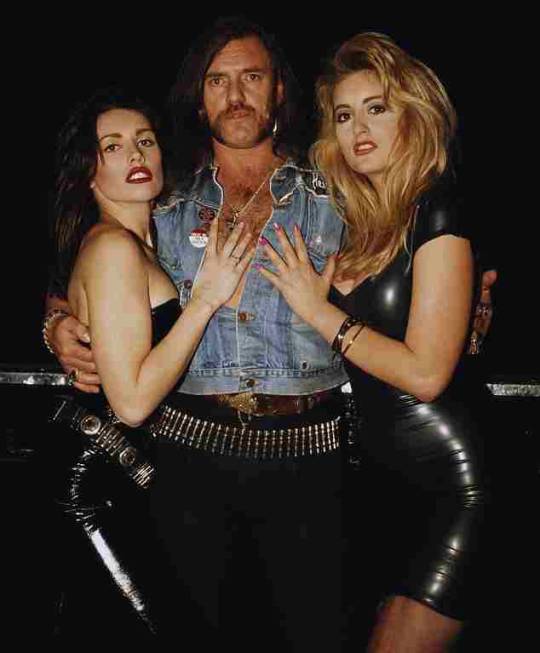
*
Lemmy picked the songs for No Remorse himself, and even provides short annotations in the liners, so if you’re going to quibble with the selections, you’ll have to take it up with the mole man. (As he says of “Like a Nightmare,” a left-field inclusion, “This was one of my favourite B-sides. Everyone didn’t like it, but seeing as I’m the only one of the old band left, here it is!!”) There are a load of Motörhead compilations out there (I’m partial to 2000’s lavish, oddly-sequenced double-CD The Best of, since it’s the one I had as a kid), and as Joey P will tell you, they did lots of good stuff after 1984. But if 1) you only need one Motörhead record on wax, 2) you’re mostly into the original lineup, and 3) you want something reasonably comprehensive, No Remorse is a no-brainer. It has a few relative duds (“Louie, Louie”) and lacks some absolute classics (“Dead Men Tell No Tales”; “Tear Ya Down”; “City Kids”; “Love Me Like a Reptile”; “White Line Fever” etc. etc.) but why complain given the teeth-rattling abundance there is? As Lemmy says, “Here is Motörhead as you’ve come to expect them. Write your opinion on a Beatle wig and send it to someone who gives a damn. Even if you get us banned, we ain’t gonna stop!”

*
Motörhead were obviously a legendary live act, and they were my first metal show (on a bill at Detroit’s Pine Knob with Dio and Iron Maiden). They played a lot of arenas, but they made the most sense in small theatres. Bigger venues tend to dwarf them, like a small motorcycle gang trying to take over a castle. In a theatre, or better yet a bar, they own the place like The Wild Ones. I don’t remember much specific from their Pine Knob set, except that before closing with “Ace of Spades,” a song Lem was famously bored of playing every night, he told us all, “You’ll know this one, sing along if you want, I won’t be able to hear you anyway,” and then abruptly launched into that hellbent bass riff. Then he disappeared (probably there was some walking beforehand, couldn’t tell you for sure).

*
Lemmy’s funeral was livestreamed back in 2015, and it’s genuinely one of the sweetest, silliest things I have ever watched. The altar features flower arrangements in the shape of the ace of spades; an iron cross in place of a crucifix; two Marshall stacks; a pair of Triple H’s wrestling boots; a 3D-printed urn in the shape of his cavalry hat; and a mirror with a big line of speed on it. Everybody cries, many of them the sort of people the PMRC would’ve expected to burst into flames if they were to enter a church. Everybody talks about how genuinely nice he was. His girlfriend Cheryl, a job that earns you instant and eternal That Poor Woman status from all who observe, gives a super brief statement: “Lemmy loved me, but his greatest love was his fans and his music. I remember saying, ‘Baby, stay home, don’t go, skip this tour. And he said, ‘Baby, I can’t. I love my fans.’” (Imagine that being an interaction between two genuine living people—yet I believe it.) Apparently, he was an absolute pinball fiend. His bootmaker gives a speech. Somebody reads some limericks Lem wrote. What a life. What a story.
youtube
*
“Can’t get enough / And you know it’s some righteous stuff / Goes up like prices at Christmas! / Motörhead / Remember me now / Motörhead, alright"

355/365
#motörhead#lemmy kilmister#lemmy#metal#punk#rock n roll#ace of spades#overkill#'70s music#'80s music#no remorse#music review#vinyl record#anecdote#tour stories
4 notes
·
View notes
Text
354: Leon Russell // Hank Wilson's Back, Vol. I
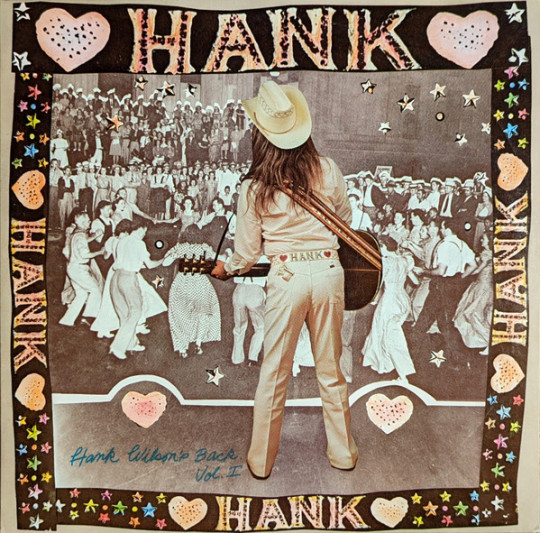
Hank Wilson's Back, Vol. I
Leon Russell
1973, Shelter
Leon Russell’s Hank Wilson’s Back Vol. I ends with a sudden burst of hysterical laughter, which is usually what I feel Leon’s doing at my expense when I listen to his records, but Hank is a pretty straight affair. We’re looking at 13 classic bluegrass and country standards, most such obvious choices that it would be a real challenge to record one of the thousand best versions of a given song, let alone a newly definitive one. None of these are that, but the record’s a breezy listen. Russell was a prolific session player before his songwriting career took off, and he puts together an all-star crew of sidemen, including J.J. Cale, Billy Byrd, and members of the Wrecking Crew, Nashville Cats, and Muscle Shoals Rhythm Section. (Plus a sleeve design by Eve Babitz!) This’ll shock, but they sound pretty good.
youtube
The more reverent arrangements (mostly on side one) are nice but not necessarily thrilling. When Russell and company give a swampier Tulsa Sound read though, you’re in for a ball. The credits to his rollicking take on Jimmie Driftwood’s “The Battle of New Orleans” list no less than six guitar players, and you can hear all of them putting in work: crunching riffs, high sitar-like accents, even a spacy steel guitar bridge. We get a nice take on Leon Payne’s “Lost Highway” too, Russell singing like he’s got a wad of chew stuffed in his cheek, the whole track bobbing along like R. Crumb’s “Keep on Truckin’” guy. Russell’s not bad on the ballads either: there’s a splendid version of “Am I That Easy to Forget” that compares well to Gram Parsons’ work from the same year on Grievous Angel.
If I were rating the record, I’d say side one is a respectable 3/5, and side two a strong 4/5—so split the difference and call it a 3.5, well worth a grab for fans of great country-western musicianship and appreciators of the ‘70s Russell/Cale/Clapton sound.
354/365
#leon russell#j.j. cale#tulsa sound#'70s music#'70s country#country music#bluegrass#eve babitz#music review#vinyl record#muscle shoals rhythm section#the wrecking crew#nashville cats
5 notes
·
View notes
Text
353: Digable Planets // Blowout Comb

Blowout Comb
Digable Planet
1994, Capitol
Blowout Comb is the best rap album ever made, and I’ve listened to it hundreds of times, but I’d be lying if I told you I knew the name of every track as it comes on. It’s not that the tracks are same-y, so much as that the record has such an endless, unified groove. No matter how great an individual song is, no matter how much I’d like to hear it again immediately, I never want to disrupt the record’s flow—and besides, there are no skips on Blowout Comb. How do I get at the particular magic at work here? It’s something like this: most everything is so laid back, from the mix tucking the three emcees’ vocals under the frequently analog bass to the way its classic soul and jazz samples are used for texture rather than hooks, that you could loop almost any single track for an hour without it becoming grating. It’s not an album of standout quotables or an iconic persona or killer hooks—it’s one that makes life feel alright, beautiful, and connected to an ancient cool.
youtube
Which isn’t to say that it doesn’t knock: the production on “Dog It,” “Jettin’,” “Agent 7,” “Blowing Down” and “9th Wonder” kicks like a rhino’s subwoofer heartbeat, and even the chillest parts feel like floating in a funky aquarium. But the song that has always stood out to me is “Black Ego,” a blissed out seven-minute dream boldly placed at track two. Built on a fluttering sample from jazz guitarist Grant Green’s “Luanna’s Theme” and a Meters’ breakbeat, producers Ish Butler and Dave Darlington layer on live bass, vibraphone, and whispered backing vocals that match the exact hiss of the cymbal hits. The seams between the sampled and live instrumentation disappear, creating a track that feels like it is improvising right alongside the emcees, riding out with a tasty two-minute long jazz guitar solo. Even at seven-minutes, I’d happily play it over—but then the enticing sax loop that opens “Dog It” hits, and Blowout Comb keeps the party rolling on to the next one.
Way back on episode #13 of this series, I covered Black Up, Ish’s 2011 comeback record as Shabazz Palaces. A strange, futuristic album that delves so deeply into glitchy electronic production that it often barely scans as a rap album at all, Black Up is nonetheless a continuation of Blowout Comb’s vision of Black pride and the historical continuum of African American music. If Blowout Comb drew that history into one time-spanning Brooklyn block party, Black Up feels a bit like that party being recalled by a cyborg from an unimaginably advanced Afrofuturist timeline. Between the two, Ish Butler created two of the freshest and most original rap records ever made. He (and his colleagues in both Digable Planets and Shabazz) deserve more mention in any conversation about hip-hop’s all-time greatest visionaries.
youtube
353/365
#digable planets#shabazz palaces#ish#ish butler#ishmael butler#'90s music#'90s rap#jazz rap#alternative hip hop#slick like that#music review#vinyl record
2 notes
·
View notes
Text
352: Eden Burns & Christopher Tubbs // Tubbs & Burns Vol. III
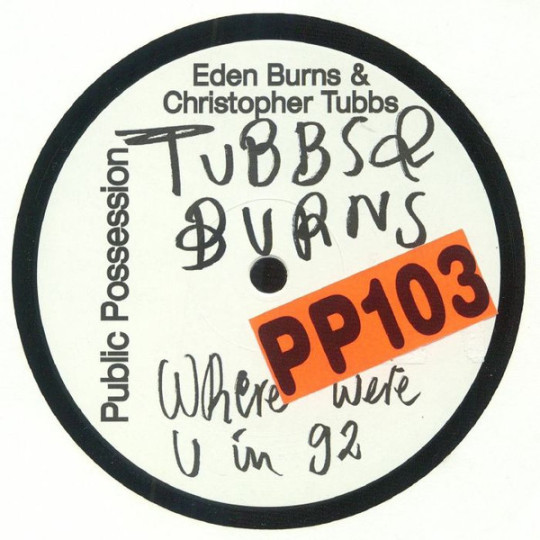
Tubbs & Burns Vol. III
Eden Burns & Christopher Tubbs
2024, Public Possession (Bandcamp)
Some real smooth tech house with a bit of a smeared Balearic euphoria to it from south New Zealand, released on Munich-based label Public Possession. I snagged this 12” EP because the guy at Montreal’s great La Rama kept on flipping it while I browsed with my friend Miles (this, immediately after telling Miles I don’t really buy white labels). I’m a sucker for “Where Were U in 92?” and its rounded bass tones and rolling rhythm, well-suited for turning a waiting room / traffic jam / grocery trip into a luxe-appointed Augmented Experience. On the flip, two mixes of “ON&ON” (featuring Kiwi jazzer and occasional DJ Nathan Haines on flute) take it to the dancefloor. The “Original Mix” has a bit of a New Age-y quality, with Haines’s flute flitting above a chirpy keyboard synth, while the aptly-named “Bullet Train Mix” is good gritty techno with a recurring percussion hit at the top of the beat that sounds like someone very aggressively double-clicking with an old grey desktop mouse.
youtube
The Burns / Tubbs partnership is a bit of an intergenerational affair, with Tubbs’s DJing career reaching back to the early ‘00s, while Burns’s earliest releases (as Speed Boat) seem to be from around the late ‘10s. The two work together nicely, and I’ll keep an ear open for more Public Possession wax in the future.
352/365
#eden burns#christopher tubbs#public possession#tech house#white label#new zealand music#new zealand#balearic#techno#electronic music#music review#vinyl record#'20s music
1 note
·
View note
Text
351: Megadeth // Rust in Peace

Rust in Peace
Megadeth
1990, Capitol
You ever have one of those arguments about art films versus mainstream movies? Or literary fiction versus genre fiction? They’re annoying! It’s too easy to get cornered into taking a side, like everyone who cares about art has only two choices: Annoying Snob or Hospice-Stage Disney Adult. I’m not sure where Rust in Peace placed on the 1990 Pazz & Jop poll or whatever, but it’s one of those records that proves the silliness of the whole enterprise: it’s absolutely a genre record in the sense that it’s by a band who cared about being thought of as Metal, and will be best appreciated by those who have listened to enough metal to know how exceptional it is as an example of its kind, but it is also exceptional by any standard. Its outlook and lyrical concerns are juvenile, which makes it feel a little embarrassing to compare to something like, say, Loveless; but if its lyrics were less fright-wigged and stoned they wouldn’t match the music, and the album would suffer for it. And as music, I don’t think Rust in Peace is a lesser album than Loveless, or The Richard D. James Album, or Perfect From Now On or whatever you’d like to put up against it from the wider world of ‘90s sound. Its relentless gold-and-cobalt fusion shape-shifting took a while to grow on me when I first bought a copy 20 years ago (just 14 years after its release, Christ…) but when it finally hit… it me hard. I still find Rust nothing less than astonishing. It’s not even the logical endpoint of thrash, but rather something that could never have been imagined in 1982. Headline: Drunk, heroin-addicted, socially-unbearable fantasy dork composes nerd rage symphony to the unknowable geometry at the centre of time. I listen to “Hanger 18” and “Lucretia” and “Rust in Peace…Polaris,” and I look at my hands with their baby guitar callouses—things like these were used to make this?
youtube
351/365
#megadeth#dave mustaine#rust in peace#thrash metal#speed metal#metal#music review#vinyl record#'90s music
6 notes
·
View notes
Text
350: Linda Smith // Nothing Else Matters
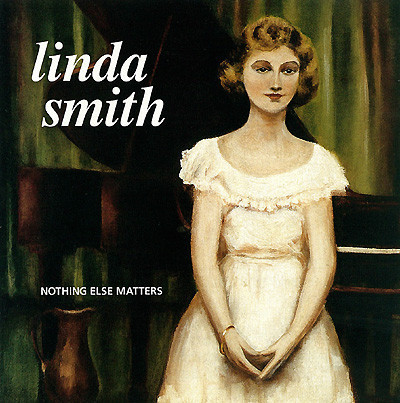
Nothing Else Matters
Linda Smith
1995, Feel Good All Over (Bandcamp)
Leaving aside commodity fetishism, shopping as a hamster-pellet dopamine hit, and surly IYKYK credentials, a big part of the appeal of physical media collecting is the way it narrows the wired world’s horribly broad array down to a single, manageable point of focus. If only for the time it takes the needle to spiral down to the centre of the disc; the tape to unspool; the laser to complete its slow read, you’ve made the gamble to choose this over the legion of that—a fidelity solidified by the cash and labour you poured into making it yours. With bedroom/self-released/obscure stuff in particular I wonder if there’s also a sense of trying to recapture that intimate feeling a lot of us have when we first encounter music that really moves us: the sense that the artist is talking to you directly. Some people are happy to know that the connection they are feeling with a Radiohead or a Taylor Swift is shared by millions of people. (Some sick fucks might find that validating, even.) But a lot of us yearn for private songs, songs like undiscovered glades or ghost metro stations.
youtube
Bedroom pop artist Linda Smith’s catalogue was reasonably well-covered during her most active years by the late ‘80s/early ‘90s fanzine press, and it’s enjoyed a small but ardent resurgence since being rediscovered by the right people in the ‘10s. (See the Sky Girl compilation, specifically.) For most of her career though, Smith’s total audience was a rounding error from nil. And the songs sound like no one’s listening too. That’s why crawling into the depths of a mid-career highlight like Nothing Else Matters feels like trying to drowse under a thin, crocheted woolen blanket on a cold autumn morning, warmth and chill fighting over the map of your skin.
The bonus cover of Young Marble Giants’ “Salad Days” that closes Captured Tracks' 2024 vinyl reissue of Nothing Else Matters is a good representative of her sound—layers of found audio mush; a somber melody played on a juvenile-sounding electric organ; pretty but introverted vocals; all of it enveloped by the throbbing safety of its bassline. So is “In the Hospital,” with its husky vocal, churchy chord progression and simple, elegant harmonies, a fantasy about how much time you’ll have for self-reflection when you’re finally, mercifully hospitalized. “I See Your Face” opens like Beat Happening trying out the “Be My Baby” beat, but turns into a just-slightly-eerie vamp—the amateur drum machine programming making the whole song judder awkwardly, the cutesy keyboard riff scooped out and hollowed.
Not every song on Nothing Else Matters has anything wildly unusual going on, and none of them feel like they’re going out of their way to be uncommercial or “uncompromising” in the manner of some art that makes a point of eschewing the label system. It simply feels like the work of a musician who felt most secure making music on her own terms, without having to worry too much about collaborators, advances, touring, promotion, attention, or any of that rot. The music existed, whether anyone was listening to it or not. But now, with Captured Tracks’ re-release of Nothing Else Matters (and its excellent follow-up I So Liked Spring), at least a few people are listening again. The attention is deserved, and rewarded.
youtube
350/365
#linda smith#captured tracks#private press#obscure music#'90s music#female singer#female musicians#beat happening#young marble giants#indie pop#alternative rock#post punk#art press#music review#vinyl record
1 note
·
View note